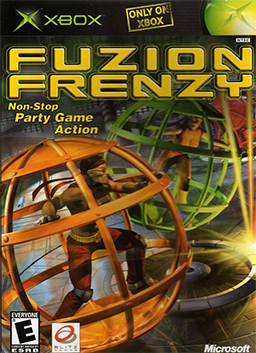Fuzion Frenzy
| Fuzion Frenzy | |
|---|---|

North American Xbox cover art
|
|
| Developer(s) | Blitz Games |
| Publisher(s) | Microsoft Game Studios |
| Platform(s) | Xbox, Xbox 360 |
| Release date(s) |
Xbox Xbox Originals
|
| Genre(s) | Party |
| Mode(s) | Single player, Multiplayer, Co-op |
| Aggregate score | |
|---|---|
| Aggregator | Score |
| Metacritic | 70/100 |
| Review scores | |
| Publication | Score |
| AllGame | |
| Edge | 3/10 |
| EGM | 3.67/10 |
| Game Informer | 6/10 |
| GamePro | |
| Game Revolution | C+ |
| GameSpot | 6.7/10 |
| GameSpy | 68% |
| GameZone | 8/10 |
| IGN | 8.3/10 |
| OXM (US) | 7.8/10 |
Fuzion Frenzy is a launch title for the Microsoft Xbox. At its core, Fuzion Frenzy is a four-player party game featuring 45 different mini-games (not including the titular Fuzion Frenzy). A demo of the game was included with some other launch titles in the US, including Halo, Munch's Oddysee, the first Project Gotham Racing game and Amped. The title was among the first to be released as a part of the Xbox Originals program.
A sequel was later released for the Xbox 360, entitled Fuzion Frenzy 2.
Up to four players can compete in two different game modes: "Tournament" or "Mini-Game Frenzy". Mini-Game Frenzy is the simpler of the two, involving players selecting individual mini-games while an ongoing tabulation of wins per player is maintained. In contrast, the Tournament mode is the core game mode, where players attempt to earn the highest number of points after playing through two or more play zones.
22 different game modes.
During game setup, players choose from one of six characters (the differences are cosmetic only), with extra player slots being filled by computer AI. The number of zones to play through is also selected (2, 4, or 6). The exact zones which are used during play (if fewer than 6) are determined randomly, in addition to the order in which the zones are played. Unlike other party games such as the Mario Party series or Sonic Shuffle, Fuzion Frenzy has no overarching game board; rather, players proceed from one random mini-game to another, and from zone to zone, in an order determined without player input. The traversal between zones is depicted as a route on a map which never crosses itself, limiting the possible transitions between zones.
...
Wikipedia
